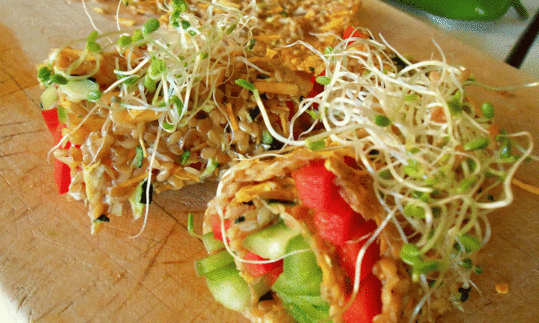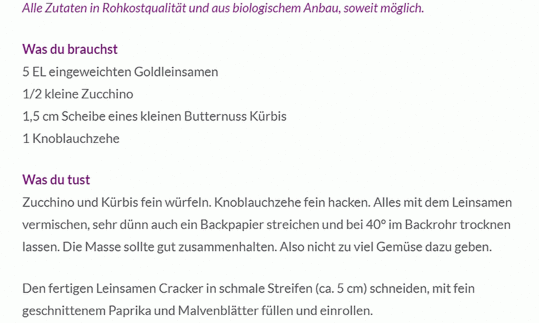Flaxseed Garlic Rolls with Zucchini and Pumpkin
raw-vegan
Ingredients (for servings, )
| 5 tbsp, whole | Linseed, raw, organic? (golden linseed, flax) (1.8 oz) |
| ½ small | Zucchini, raw, (organic?) (2.1 oz) |
| 2 ⅔ oz | Butternut squash, raw (pear squash), one butternut squash |
| 1 clove | Garlic (organic?) (0.11 oz) |
Equipment
- dehydrator or oven
Type of preparation
- dehydrate
- chop or grind
- food preparation without heating
- soak
- drain
Preparation
preparation (the day before)
Soak flax seeds overnight. Drain off excess water (if any).For the flaxseed crackers
Finely dice the zucchini and pumpkin. Finely chop the garlic clove.
Mix everything with the soaked linseed, spread very thinly on baking paper and leave to dry in the dehydrator or in the oven at 40° C for about 4-6 hours.The original recipe uses half of a small zucchini and 1.5 cm of butternut squash (on average about 75 g for an 850 g pumpkin) for 2 portions.
The mixture should hold together well. So don't add too many vegetables and check it at regular intervals, as the original recipe doesn't provide any more precise information.
Arranging and Serving
Cut the finished linseed cracker into thin strips (approx. 5 cm), fill with finely chopped peppers, fresh sprouts or mallow leaves, for example, and roll up.
|
Nutritional Information per person
Convert per 100g
|
2000 kcal | |
|---|---|---|
| Energy | 152 kcal | 7.6% |
| Fat/Lipids | 11 g | 15.8% |
| Saturated Fats | 1.0 g | 5.0% |
| Carbohydrates (inc.dietary fiber) | 10 g | 3.8% |
| Sugars | 2.2 g | 2.5% |
| Fiber | 7.7 g | 30.9% |
| Protein/Albumin | 5.5 g | 11.1% |
| Cooking Salt (Na:11.1 mg) | 28 mg | 1.2% |
| Essential micronutrients with the highest proportions | per person | 2000 kcal | |
|---|---|---|---|
| Fat | Alpha-Linolenic acid; ALA; 18:3 omega-3 | 5.9 g | 295.0% |
| Vit | Vitamin B1 (Thiamine) | 0.46 mg | 42.0% |
| Min | Manganese, Mn | 0.78 mg | 39.0% |
| Min | Copper, Cu | 0.37 mg | 37.0% |
| Prot | Tryptophan (Trp, W) | 0.08 g | 33.0% |
| Elem | Magnesium, Mg | 114 mg | 30.0% |
| Elem | Phosphorus, P | 191 mg | 27.0% |
| Prot | Threonine (Thr, T, irreversibly transaminated) | 0.22 g | 23.0% |
| Prot | Isoleucine (Ile, I) | 0.26 g | 21.0% |
| Vit | Vitamin A, as RAE | 165 µg | 21.0% |
Detailed Nutritional Information per Person for this Recipe
The majority of the nutritional information comes from the USDA (US Department of Agriculture). This means that the information for natural products is often incomplete or only given within broader categories, whereas in most cases products made from these have more complete information displayed.
If we take flaxseed, for example, the important essential amino acid ALA (omega-3) is only included in an overarching category whereas for flaxseed oil ALA is listed specifically. In time, we will be able to change this, but it will require a lot of work. An “i” appears behind ingredients that have been adjusted and an explanation appears when you hover over this symbol.
For Erb Muesli, the original calculations resulted in 48 % of the daily requirement of ALA — but with the correction, we see that the muesli actually covers >100 % of the necessary recommendation for the omega-3 fatty acid ALA. Our goal is to eventually be able to compare the nutritional value of our recipes with those that are used in conventional western lifestyles.
| Essential fatty acids | per person | 2000 kcal |
|---|---|---|
| Alpha-Linolenic acid; ALA; 18:3 omega-3 | 5.9 g | 295.0% |
| Linoleic acid; LA; 18:2 omega-6 | 1.5 g | 15.0% |
| Essential amino acids | per person | 2000 kcal |
|---|---|---|
| Tryptophan (Trp, W) | 0.08 g | 33.0% |
| Threonine (Thr, T, irreversibly transaminated) | 0.22 g | 23.0% |
| Isoleucine (Ile, I) | 0.26 g | 21.0% |
| Valin (Val, V) | 0.31 g | 19.0% |
| Phenylalanine (Phe, F) | 0.27 g | 18.0% |
| Leucine (Leu, L) | 0.36 g | 15.0% |
| Lysine (Lys, K, irreversibly transaminated) | 0.26 g | 14.0% |
| Methionine (Met, M) | 0.11 g | 12.0% |
| Vitamins | per person | 2000 kcal |
|---|---|---|
| Vitamin B1 (Thiamine) | 0.46 mg | 42.0% |
| Vitamin A, as RAE | 165 µg | 21.0% |
| Vitamin B9, B11 (Folate, as the active form of folic acid) | 37 µg | 18.0% |
| Vitamin C (ascorbic acid) | 13 mg | 16.0% |
| Vitamin B6 (pyridoxine) | 0.23 mg | 16.0% |
| Vitamin B7 (Biotin, ex vitamin H) | 4.2 µg | 8.0% |
| Vitamin B3 (Niacin) | 1.1 mg | 7.0% |
| Vitamin B2 (Riboflavin) | 0.09 mg | 6.0% |
| Vitamin B5 (Pantothenic acid) | 0.38 mg | 6.0% |
| Vitamin K | 3.6 µg | 5.0% |
| Vitamin E, as a-TEs | 0.16 mg | 1.0% |
| Essential macroelements (macronutrients) | per person | 2000 kcal |
|---|---|---|
| Magnesium, Mg | 114 mg | 30.0% |
| Phosphorus, P | 191 mg | 27.0% |
| Potassium, K | 376 mg | 19.0% |
| Calcium, Ca | 81 mg | 10.0% |
| Sodium, Na | 11 mg | 1.0% |
| Essential trace elements (micronutrients) | per person | 2000 kcal |
|---|---|---|
| Manganese, Mn | 0.78 mg | 39.0% |
| Copper, Cu | 0.37 mg | 37.0% |
| Iron, Fe | 1.8 mg | 13.0% |
| Zinc, Zn | 1.3 mg | 13.0% |
| Selenium, Se | 6.9 µg | 13.0% |
| Iod, I (Jod, J) | 0.56 µg | < 0.1% |
| Fluorine, F | 0.75 µg | < 0.1% |
These delicious linseed garlic rolls with zucchini and butternut squash can be filled with peppers and fresh sprouts, for example.
Serving size: We have designed the recipe as a snack or starter for 2 portions. This is a recipe just for the flaxseed garlic crackers. The ingredients for the filling are not included.
Time required: The high time requirement is primarily due to soaking the linseed and drying the crackers. The first step can easily be done the day before.
Nutrient profile: According to GDA guidelines, one portion of this recipe covers almost three times the recommended daily requirement of omega-3 fatty acids. Vitamin B1 and manganese are covered by 40%. The omega-3 fatty acids play a role in reducing inflammatory processes. Vitamin B1 fulfils many tasks in energy metabolism and the nervous system. The trace element manganese is found primarily in plant-based, unrefined foods and plays a role in the formation of cartilage tissue, among other things.
The ratio of omega-6 to omega-3 fatty acids is an excellent 1:4.
You can find out more at the following link: Vegans often eat unhealthily. Avoidable nutritional errors.
Linseed: Linseed is the seed of the flax plant (common flax, Linum usitatissimum). Linseed has a slightly nutty taste and a fat content of around 40%. Half of this is alpha-linolenic acid, a polyunsaturated omega-3 fatty acid. Therefore, linseed oil has the highest omega-3 fatty acid concentration of all known vegetable oils.
Zucchini: Zucchini is easy to digest, low in calories and rich in vitamins. Be careful with bitter-tasting zucchini. The bitter taste is caused by the poisonous bitter substances cucurbitacins. These cannot be destroyed by cooking and attack the stomach and intestinal mucosa. An increased content of bitter substances can arise, especially when grown at home (by backcrossing home-grown seeds or crossing with other pumpkin plants).
Butternut squash: The butternut squash has a relatively thin skin and a high proportion of light orange flesh, which has a buttery, slightly nutty aroma. The butternut squash has a high content of beta-carotene, which is good for skin, hair and eyesight. 100 g of butternut squash covers around 80% of the daily requirement of beta-carotene. It also contains plenty of vitamin C. Compared to other types of squash, it contains relatively high calories but hardly any fat.
The butternut squash can also be eaten raw, as in this recipe.
Raw food and temperature: Raw food is defined as natural foods that do not exceed a temperature of 42°C before they are prepared. Above this temperature, many proteins in natural food denature, which means that a line is drawn between cooked and raw food. Many household ovens do not allow their temperature to be regulated below 50°C. In this case, opening the oven a crack allows an internal temperature of less than 50°C. Nevertheless, dehydrators are a reliable alternative for those who follow a more strict raw food diet.
In the United States, raw food preparation is often accepted as long as the ingredients are not heated above 47 °C.
Oven or dehydrator: As mentioned in the tips, you can dry this dish either in the oven (at 50 °C convection with a gap-wide opening) or in the dehydrator.





